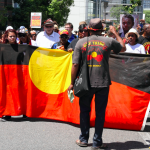Reducing Indigenous Crime: Mass Incarceration is Not the Answer

Aboriginal and Torres Strait Islander people are the most incarcerated on earth by percentage of their population. Currently, the Indigenous incarceration rate in Australia is 2,430 inmates per 100,000 adults.
In March this year, there were 11,288 Indigenous adults detained in the Australian prison system. The nation’s First Peoples account for only 2.8 percent of the overall Australian population, however, they represent 28 percent of the prisoner population.
The proportion of the Australian prison population made up of Indigenous people has doubled from the 14 percent it was in 1991, which was the year the Royal Commission into Aboriginal deaths in custody delivered its findings.
The royal commission made 339 recommendations, most of which have never been implemented.
The commission’s eighty seventh recommendation states, “arrest people only when no other way exists for dealing with a problem,” while the ninety second reads, “imprisonment should be utilised only as a sanction of last resort.”
Despite these recommendations, the number of Aboriginal and Torres Strait Islander people being locked up has skyrocketed over recent decades.
Mass incarceration in NSW
NSW is the greatest incarcerator in the nation. The state imprisons 3,184 Indigenous inmates, representing 28 percent of Australia’s incarcerated First Peoples.
Between 2013 and 2016, the Aboriginal and Torres Strait Islander imprisonment rate in NSW grew by 25 percent. Today, the rate of Indigenous imprisonment in this state is 13.5 times higher than the non-Indigenous imprisonment rate.
Last week, the NSW Bureau of Crime Statistics and Research (BOCSAR) released a report arising from its investigation into the dramatic increase in the Indigenous prisoner population in NSW over the period 2012 and 2016.
Titled Indigenous Imprisonment in NSW: A Closer Look at the Trend, the report asserts that if some simple adjustments were made to the NSW criminal justice system, the number of Indigenous inmates could be lowered by over 500 per year.
An increase in those being charged
The number of First Nations peoples being taken into custody has spiked by 79 extra a month over the last five years. In January 2012, there were on average 359 Indigenous adults ending up behind bars on a monthly basis, whereas the figure rose to 438 a month by December 2016.
Those sentenced to imprisonment also increased over that time period. During 2012, an average of 279 Indigenous people were imprisoned per month, which increased to 373 a month in 2016.
The overall percentage of Indigenous offenders being sentenced to imprisonment has also increased. In 2012, an average of 17.4 percent of Indigenous offenders received a prison sentence, which increased to 20.06 percent in the 12 months ending September 2016.
The numbers of Indigenous defendants convicted of an offence also increased over that time, with 1,352 per month in the first 12 months increasing to 1,661 a month in the last 12 months.
There was also a significant rise in the amount of Indigenous defendants appearing in court on criminal charges. The researchers concluded that most of the increase in Indigenous convictions was due to heavier policing, with police preferring to charge Indigenous people rather than caution them or attempt to defuse the situation.
The major findings
The report ultimately concluded that three factors are primarily responsible for the growth in Indigenous incarceration in NSW.
The first is the significant increase in Indigenous people being charged, especially for the offences of stalking or intimidation, and breaching a section 9 or 12 bond.
The second is a spike in the proportion of Indigenous offenders receiving prison sentences, especially for the offence of stalking or intimidation.
The third is a significant increase in the time spent on remand by Aboriginal and Torres Strait Islander inmates, which is primarily due to tougher bail laws and delays in the NSW District Criminal Court.
Increased policing and enforcement measures
The researchers questioned why there would be such an abrupt increase in prison sentences for stalking or intimidation offences over recent years.
They reasoned that there’s no recent cause for such an increase in the commission of the offence itself, and it’s more likely a change in policing and enforcement policy, which in turn has led to a rapid rise in convictions.
According to the BOCSAR researchers, it’s difficult to know why these changes in policy have been implemented.
However, they do note that the offence of stalking or intimidation doesn’t actually require proof that the victim felt any physical or mental harm, and yet it carries a maximum penalty of 5 imprisonment.
The offence also attracts a “show cause” requirement to be eligible for bail. This means it’s more likely for someone charged with this offence to be held on remand, which is when they’re refused bail and have to await the finalisation of their case in prison.
Under the Bail Amendment Act 2014, people now have to show cause as to why their detention isn’t justified if they’re charged with any one of more than 900 different offences.
Enforcing bond breaches
Most bond breaches are discovered by police – or parole officers – rather than reported, so it’s likely that the rise in court appearances for these offences is due in a large part to a change in enforcement policy, rather than any sort of major change in offending behaviour.
A section 9 bond is a good behaviour bond that comes with a criminal conviction and can last up to 5 years, while a section 12 is a bond that’s also referred to as a suspended sentence, and it can last for up to two years.
Curbing Indigenous incarceration
The researchers pointed out that all but two of 1,380 Indigenous people convicted in 2015 of assault occasioning actual bodily harm, intimidation or stalking, common assault, breaching a section 9 or 12 bond, or breaching an apprehended violence order received a sentence of less than 24 months imprisonment. And 92 percent of them received less than a 12 month prison sentence.
This means that the vast majority of those convicted for these offences were eligible for home detention or an intensive correction order – penalties that do not involve prison time.
Those sentenced to less than 18 months may be eligible for home detention, while those given less than 24 months may be eligible for an intensive correction order.
Non-custodial sentences should be utilised
What’s more, there’s evidence that both these alternative penalties lead to lower reoffending rates than full time imprisonment. However, these sanctions are less frequently used on Indigenous than non-Indigenous people, due to a range of factors including barriers such as homelessness and a lack of available services in remote areas.
“Removal of these barriers would assist in expanding the use” of non-custodial sentences, and, as the researchers point out, reduce the rate of Indigenous imprisonment.
If half of the inmates in 2015 who received prison sentences for the above-mentioned offences were given non-custodial options, then there would have been “689 fewer Indigenous offenders” sent to NSW correctional facilities that year, the BOCSAR researchers concluded.








